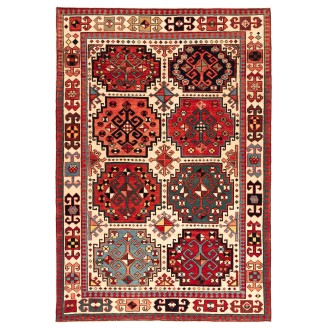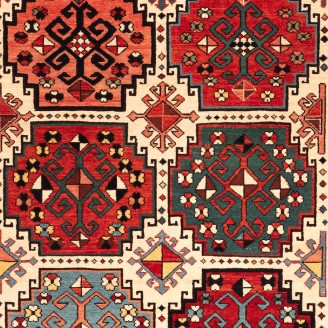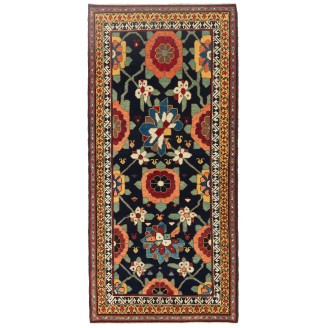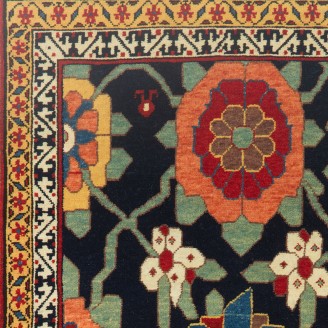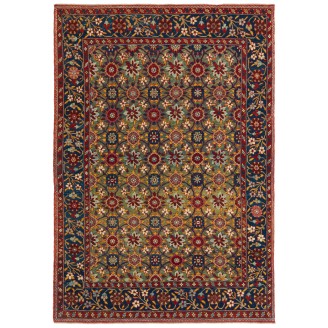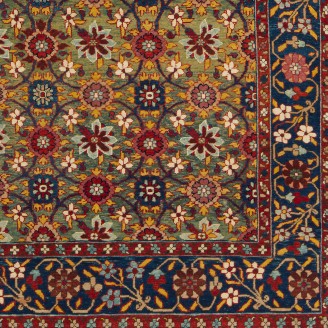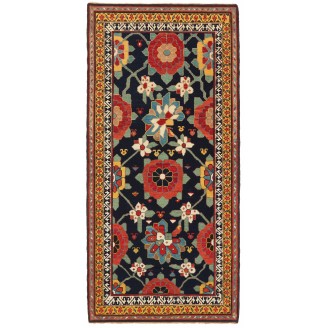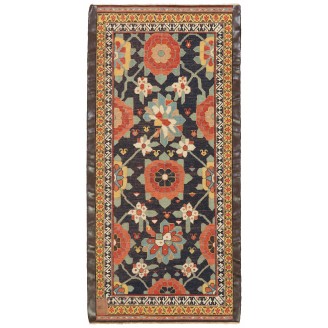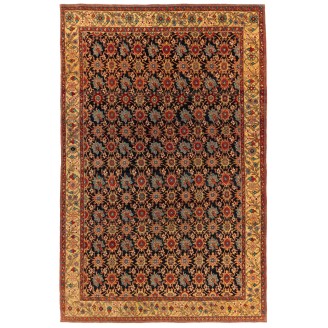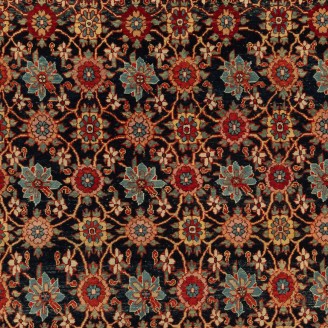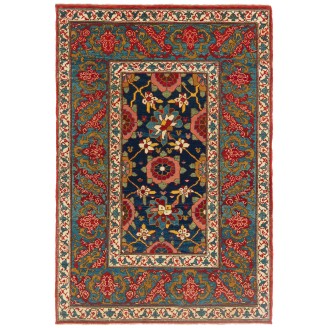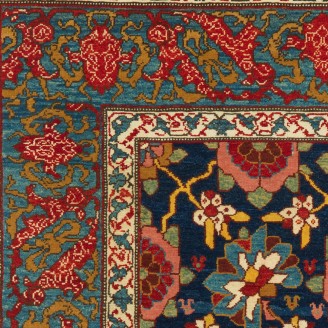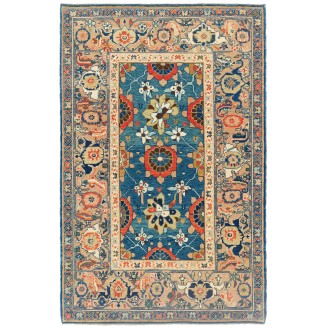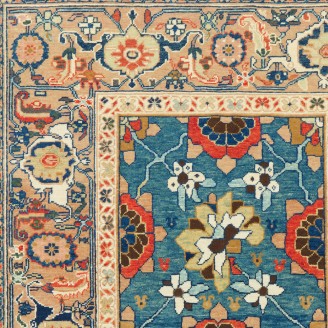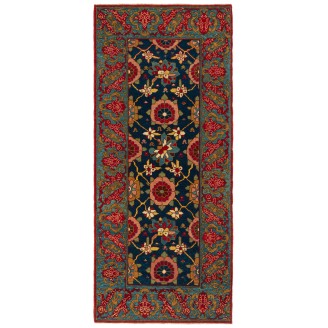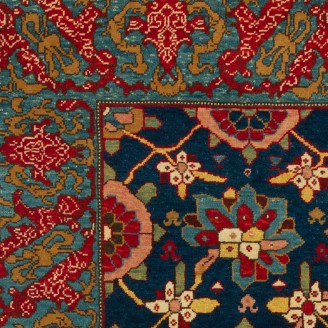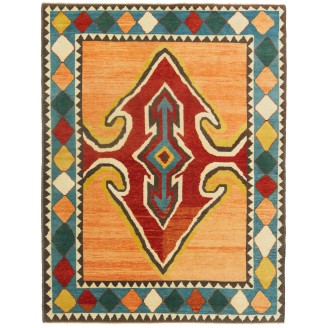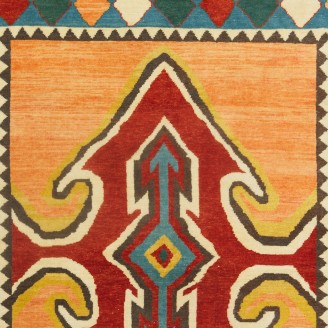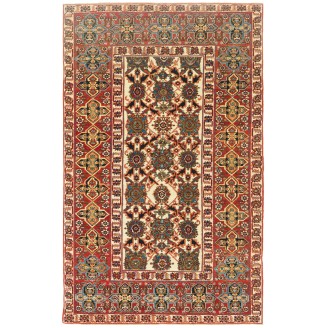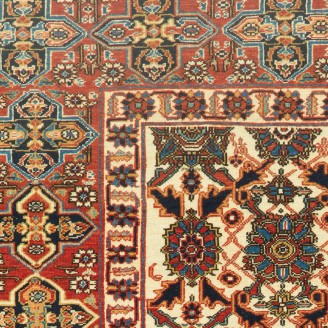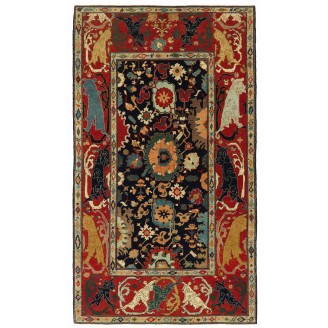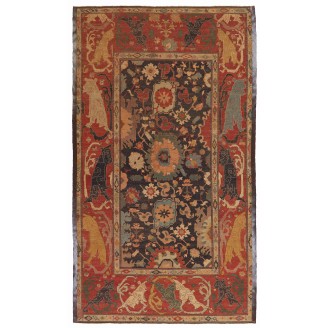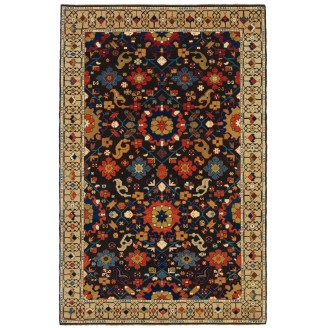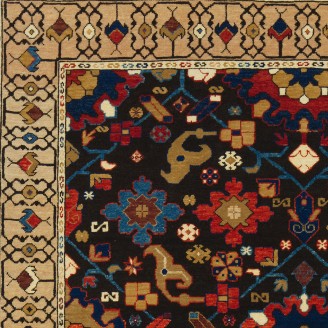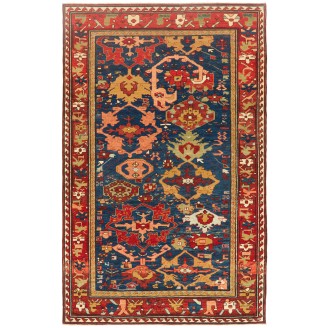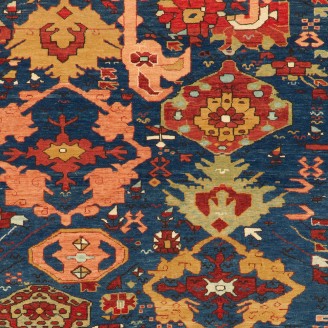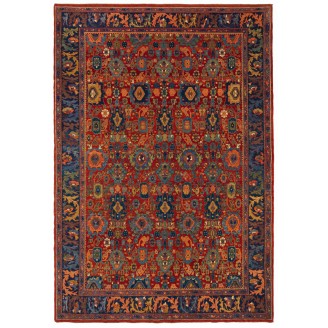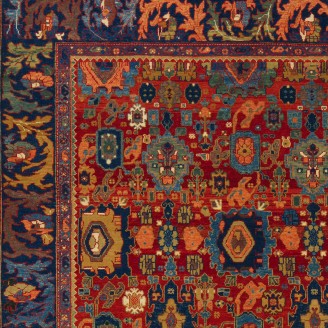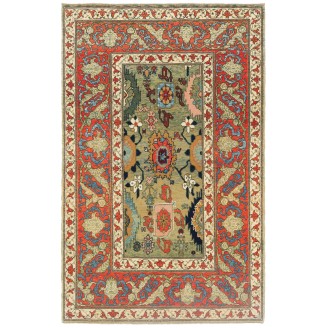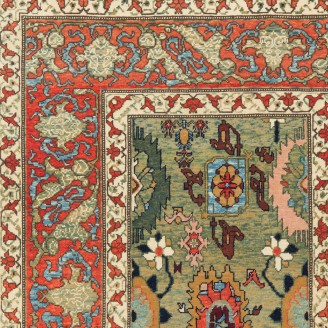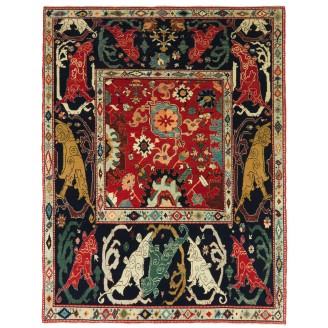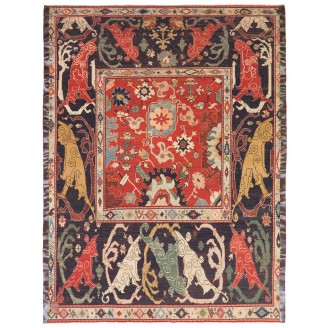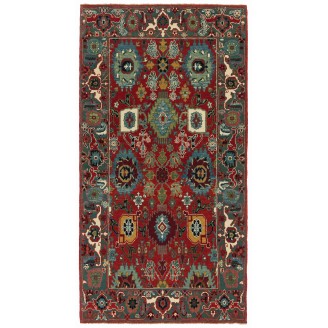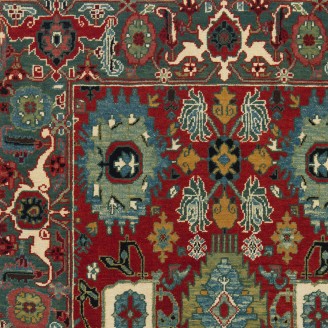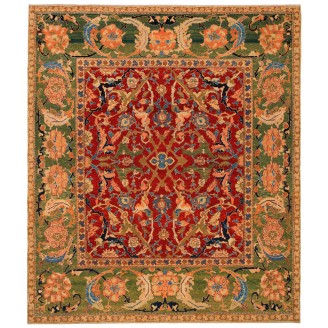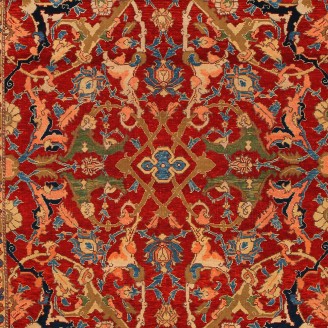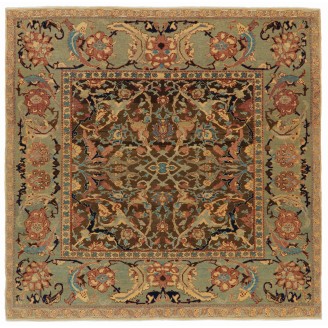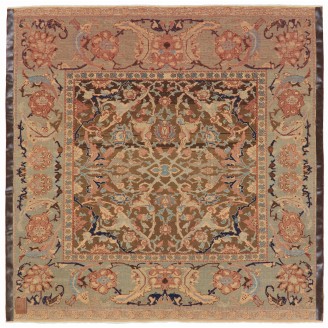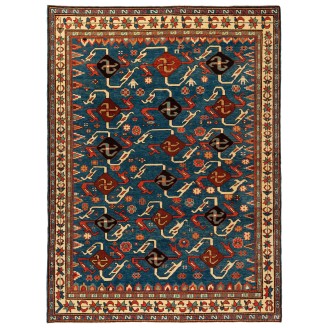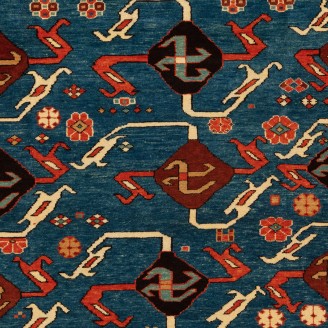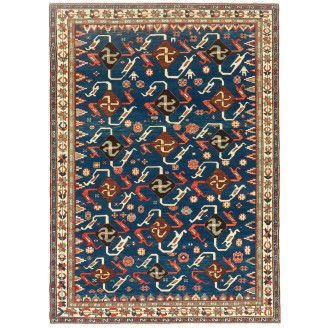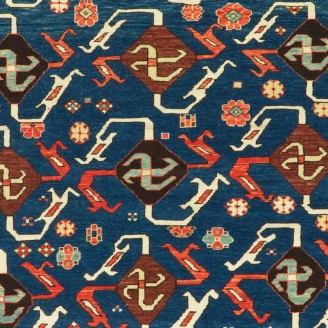Model: ART00008
Dimensions: 3'10" X 5'6"(118cm x 169cm)
The source of the rug comes from the book Tapis du Caucase - Rugs of the Caucasus, Ian Bennett & Aziz Bassoul, The Nicholas Sursock Museum, Beirut, Lebanon 2003, nr.24 and Oriental Rugs Volume 1 Caucasian, Ian Bennett, Oriental Textile Press, Aberdeen 1993, nr.68 and Caucasian Carpets, E. Gans-R..
Price:
$5,200
Ex Tax:$5,200
Model: ART00616
Dimensions: 2'8" X 5'8"(83cm x 174cm)
The source of the rug comes from the book Antique Rugs of Kurdistan A Historical Legacy of Woven Art, James D. Burns, 2002 nr.4. This was an exclusive example of a Mina Khani lattice design mid-19th century rug from Koliya'i, Southern Kurdistan area. The mina khani is composed of a se..
Price:
$3,130
Ex Tax:$3,130
Model: ART00487
Dimensions: 4'9" X 6'11"(147cm x 211cm)
The source of the rug comes from the book Antique Rugs of Kurdistan A Historical Legacy of Woven Art, James D. Burns, 2002 nr.2. This was an exclusive example of a Mina Khani lattice design mid-19th century rug from Koliya'i, Southern Kurdistan area. The mina khani is composed of a series of rows of..
Price:
$5,900
Ex Tax:$5,900
Model: ART00674
Dimensions: 2'9" X 5'8"(84cm x 173cm)
Introducing the exquisite Kurdish Bidjar Mina Khani Rug (Model: ART00674) from Ararat Rugs, a masterpiece that exemplifies the rich weaving traditions of the Bidjar region in Northwest Persia. This handwoven rug features the intricate Minahani design, celebrated for its harmonious blend of..
Price:
$2,800
Ex Tax:$2,800
Model: ART00216
Dimensions: 6'5" X 10'0"(198cm x 306cm)
The source of the rug comes from the book Antique Rugs of Kurdistan A Historical Legacy of Woven Art, James D. Burns, 2002 nr.2. This was an exclusive example of a Mina Khani lattice design mid-19th century rug from Koliya'i, Southern Kurdistan area. The mina khani is composed of a series of rows of..
Price:
$18,000
Ex Tax:$18,000
Model: ART00493
Dimensions: 3'4" X 4'11"(104cm x 152cm)
The design source of the rug comes from the book Antique Rugs of Kurdistan A Historical Legacy of Woven Art, James D. Burns, 2002 nr.4. This was an exclusive example of a Mina Khani lattice design mid-19th century rug from Koliya'i, Southern Kurdistan area. The mina khani is composed ..
Price:
$3,430
Ex Tax:$3,430
Model: ART00514
Dimensions: 3'4" X 5'2"(104cm x 160cm)
The source of the rug comes from the book Antique Rugs of Kurdistan A Historical Legacy of Woven Art, James D. Burns, 2002 nr.4. This was an exclusive example of a Mina Khani lattice design mid-19th century rug from Koliya'i, Southern Kurdistan area. The mina khani is composed of a se..
Price:
$2,880
Ex Tax:$2,880
Model: ART00494
Dimensions: 2'9" X 6'3"(84cm x 192cm)
The source of the rug comes from the book Antique Rugs of Kurdistan A Historical Legacy of Woven Art, James D. Burns, 2002 nr.4. This was an exclusive example of a Mina Khani lattice design mid-19th century rug from Koliya'i, Southern Kurdistan area. The mina khani is composed of a series of rows of..
Price:
$2,760
Ex Tax:$2,760
Model: ART00496
Dimensions: 4'7" X 6'0"(142cm x 185cm)
This Gabbeh rug, designed in the 1930s, is a type of handwoven rug that originated from Iran, specifically from the southwestern region known as Fars. The word "Gabbeh" itself means "raw" or "natural" in Persian, reflecting the simplicity and primitive charm of these rugs. Gabbeh rugs are traditiona..
Price:
$2,860
Ex Tax:$2,860
Model: ART00617
Dimensions: 4'7" X 7'2"(140cm x 219cm)
The design source of the rug comes from the book Caucasian Carpets, E. Gans-Reudin, Thames and Hudson, Switzerland 1986, pg.284. This is a spectacular example of the Orducth-Konagkend type rug in the late 19th century in the Kuba region, Caucasus. There are three principal designs for rugs attr..
Price:
$5,330
Ex Tax:$5,330
Model: ART00716
Dimensions: 10'2" X 5'10"(310cm x 179cm)
This offset pattern is composed of palmettes and flowers, one has the impression that it is only part of a larger scheme designed 19th-century rugs from the Bidjar region, Eastern Kurdistan area. Very similar palmettes, drawn in a curvilinear manner and combined with identical forked leaves, can be ..
Price:
$11,650
Ex Tax:$11,650
Model: ART00542
Dimensions: 4'8" X 7'3"(144cm x 221cm)
This offset pattern is composed of palmettes and flowers, one has the impression that it is only part of a larger scheme designed 19th-century rug from the Bidjar region, Eastern Kurdistan area. Very similar palmettes, drawn in a curvilinear manner and combined with identical forked leaves, can be s..
Price:
$6,000
Ex Tax:$6,000
Model: ART00608
Dimensions: 4'10" X 7'8"(149cm x 234cm)
This offset pattern is composed of palmettes and flowers, one has the impression that it is only part of a larger scheme designed for 19th-century rugs from the Bidjar region, Eastern Kurdistan area. Very similar palmettes, drawn in a curvilinear manner and combined with identical forked leaves, can..
Price:
$7,300
Ex Tax:$7,300
Model: ART00547
Dimensions: 6'6" X 9'6"(200cm x 290cm)
This offset pattern is composed of palmettes and flowers, one has the impression that it is only part of a larger scheme designed for 19th-century rugs from the Bidjar region, Eastern Kurdistan area. Very similar palmettes, drawn in a curvilinear manner and combined with identical forked leaves, can..
Price:
$18,000
Ex Tax:$18,000
Model: ART00513
Dimensions: 3'4" X 5'3"(104cm x 162cm)
This offset pattern is composed of palmettes and flowers, one has the impression that it is only part of a larger scheme designed for 19th-century rugs from the Bidjar region, Eastern Kurdistan area. Very similar palmettes, drawn in a curvilinear manner and combined with identical forked leaves, can..
Price:
$2,920
Ex Tax:$2,920
Model: ART00715
Dimensions: 6'0" X 7'10"(184cm x 240cm)
Introducing the exquisite Palmettes and Flower Lattice Rug (Model: ART00715) from Ararat Rugs, a masterful representation of traditional Persian craftsmanship. This handwoven rug showcases the intricate "Palmettes and Flowers Lattice" design, a pattern deeply rooted in the rich history of ..
Price:
$8,000
Ex Tax:$8,000
Model: ART00603
Dimensions: 5'7" X 2'11"(171cm x 91cm)
This offset pattern is composed of palmettes and flowers, one has the impression that it is only part of a larger scheme designed for 19th-century rugs from the Bidjar region, Eastern Kurdistan area. Very similar palmettes, drawn in a curvilinear manner and combined with identical forked leaves, can..
Price:
$3,150
Ex Tax:$3,150
Model: ART00264
Dimensions: 5'11" X 6'11"(181cm x 213cm)
The source of the carpet comes from the book Oriental Rugs in the Metropolitan Museum of Art, Dimand, Maurice S., and Jean Mailey, The Metropolitan Museum of Art, New York 1973 fig.90. If the so-called vase-technique carpets represented the triumph of Safavid workshop weaving in the seventeenth cent..
Price:
$8,800
Ex Tax:$8,800
Model: ART00329
Dimensions: 5'10" X 5'11"(180cm x 182cm)
The source of the carpet comes from the book Oriental Rugs in the Metropolitan Museum of Art, Dimand, Maurice S., and Jean Mailey, The Metropolitan Museum of Art, New York 1973 fig.90. If the so-called vase-technique carpets represented the triumph of Safavid workshop weaving in the seventeenth..
Price:
$7,800
Ex Tax:$7,800
Model: ART00408
Dimensions: 6'7" X 8'9"(201cm x 268cm)
The source of the rug comes from the book Orient Star - A Carpet Collection, E. Heinrich Kirchheim, Hali Publications Ltd, 1993 nr.17. This is a remarkable and very unusual swastika designed early 19th-century rug from the Central Caucasus area. This unusual pattern is not known on other rugs but is..
Price:
$9,200
Ex Tax:$9,200
Model: ART00610
Dimensions: 5'6" X 7'8"(170cm x 235cm)
The source of the rug comes from the book Orient Star - A Carpet Collection, E. Heinrich Kirchheim, Hali Publications Ltd, 1993 nr.17. This is a remarkable and very unusual swastika designed early 19th-century rug from the Central Caucasia area. This unusual pattern is not known on ot..
Price:
$6,950
Ex Tax:$6,950
